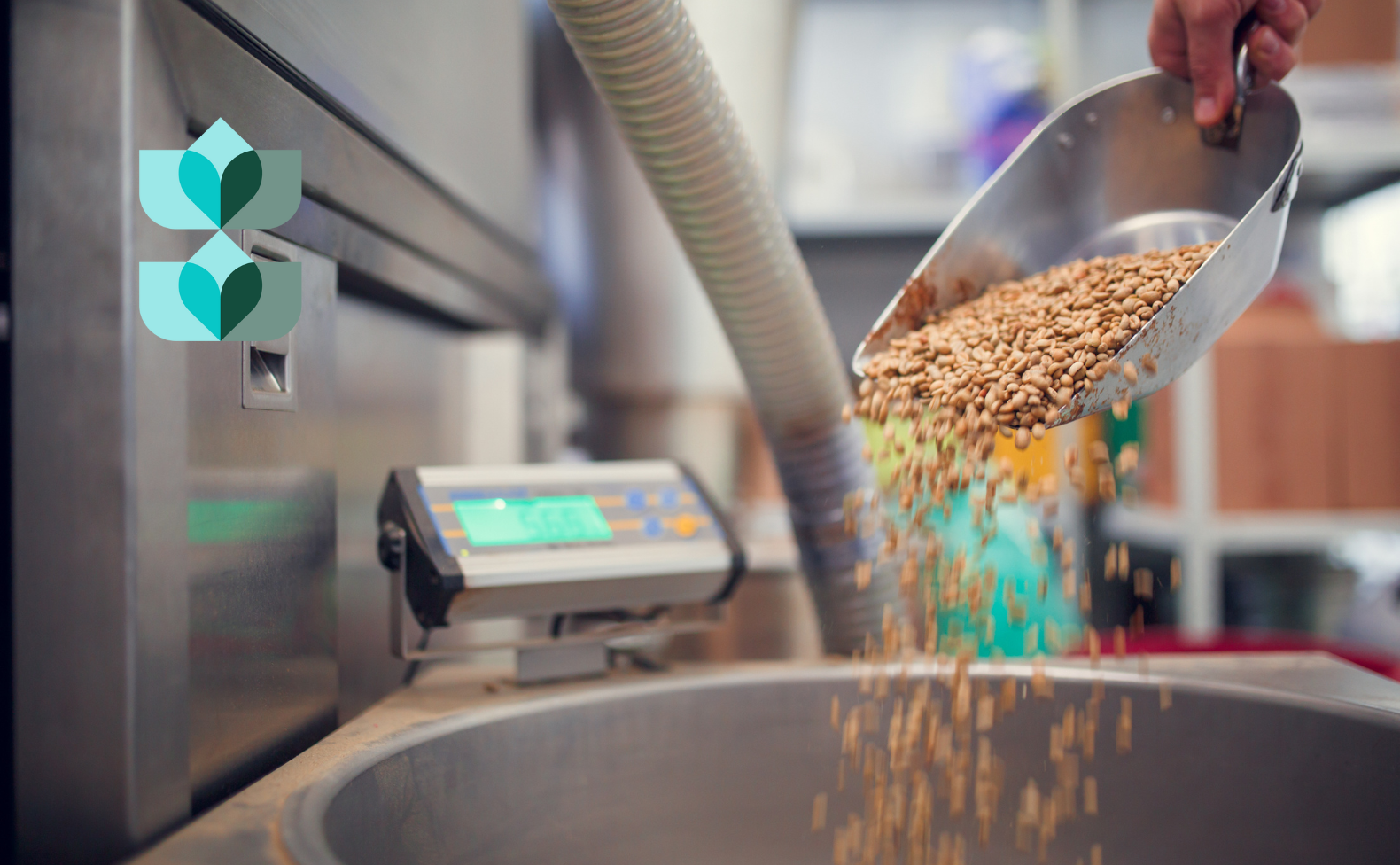Food Manufacturing companies are always looking for ways to improve the overall efficiency of their operations. Choosing the right food manufacturing software goes a long way to securing the best possible solution for their particular business. One element in particular, user-friendliness, plays a monumental role in choosing food manufacturing software.
What Is Food Manufacturing Software and Why Do Businesses Use It?
.jpg?width=1580&height=976&name=Copy%20of%20Copy%20of%20Copy%20of%20Process%20Manufacturing%20ERP%20(16).jpg)
Food manufacturing software, also known as food production software or food ERP (Enterprise Resource Planning) software, is a specialized technology solution designed to streamline and optimize various processes involved in the production and management of food and beverage products. It provides comprehensive tools and functionalities that cater specifically to the unique requirements of the food manufacturing industry.
Food manufacturing involves a complex set of activities, including recipe management, ingredient tracking, inventory control, production planning and scheduling, quality control, compliance with food safety regulations, traceability, and more. Managing these processes efficiently and effectively is crucial for food manufacturers to ensure product consistency, safety, compliance, and profitability. Food manufacturing software serves as a central hub that integrates and automates these processes, enabling businesses to operate more efficiently and make data-driven decisions.
Here are some key aspects and functionalities of food manufacturing software:
Recipe and Formulation Management:
Food manufacturing software allows businesses to create, store, and manage recipes and formulations for their products. It provides a centralized repository where detailed recipes, ingredient lists, quantities, and instructions can be documented. This functionality ensures consistency in product quality and facilitates easy scaling of recipes to meet different production volumes.
Inventory Management:
Efficient inventory management is critical in the food industry to avoid stockouts, minimize waste, and optimize costs. Food manufacturing software helps in tracking and managing raw materials, ingredients, packaging materials, and finished goods inventory levels. It provides real-time visibility into inventory status, automated replenishment triggers, and tools for managing expiration dates and lot tracking.
Production Planning and Scheduling:
Food manufacturing software assists in planning and scheduling production activities based on demand, available resources, and production capacity. It helps optimize production sequences, allocate resources effectively, and create production schedules that minimize downtime and maximize efficiency. This functionality also considers factors like order prioritization, production lead times, and machine and labor availability.
Quality Control and Assurance:
Maintaining high quality and ensuring compliance with food safety regulations is a top priority for food manufacturers. Food manufacturing software offers quality control modules to track and monitor product quality at every stage of the production process. It enables the implementation of quality assurance programs, capturing and analyzing quality data, conducting inspections, managing non-conformities, and facilitating corrective and preventive actions (CAPA).
Traceability and Recall Management:
In the event of a product recall or quality issue, traceability becomes crucial to identify and isolate affected products. Food manufacturing software provides traceability features that enable businesses to track the movement of ingredients and finished products throughout the supply chain. This includes tracking the origin of ingredients, lot and batch information, production dates, and distribution details. In case of a recall, the software facilitates quick and accurate identification and retrieval of affected products.
.jpg?width=1580&height=976&name=Copy%20of%20Copy%20of%20Copy%20of%20Process%20Manufacturing%20ERP%20(19).jpg)
Compliance and Regulatory Support:
The food industry is subject to various regulations and standards, such as food safety regulations, labeling requirements, allergen declarations, and more. Food manufacturing software helps businesses adhere to these regulations by providing built-in compliance checks, documentation management, and reporting capabilities. It assists in generating regulatory reports, managing certifications, and ensuring adherence to industry standards.
Real-time Analytics and Reporting:
Food manufacturing software offers advanced reporting and analytics capabilities that provide real-time insights into key performance indicators (KPIs) and operational metrics. Businesses can monitor production efficiency, quality metrics, inventory levels, waste, and other performance indicators. These insights help identify bottlenecks, improve decision-making, and drive continuous improvement initiatives.
Integration and Collaboration:
Food manufacturing software can integrate with other business systems, such as enterprise resource planning (ERP), supply chain management (SCM), customer relationship management (CRM), and financial management systems. The integration allows seamless data flow across different departments, improves collaboration, and eliminates manual data entry and duplication errors.
Mobile Capabilities:
Many food manufacturing software solutions offer mobile applications or responsive interfaces that enable access to critical information and functionalities on smartphones and tablets. This allows production managers, quality control personnel, and other stakeholders to monitor and manage operations remotely, even on the shop floor.
Scalability and Flexibility:
Food manufacturing software should be scalable to accommodate business growth and changes in production volumes. It should be capable of handling multiple production lines, multiple sites, and diverse product portfolios. The software should also be flexible to adapt to evolving business needs and industry trends.
Choosing the right food manufacturing software requires careful evaluation of the specific needs and goals of your business. Factors to consider include the size and complexity of your operations, regulatory compliance requirements, integration needs, budget, and vendor reputation. It is advisable to involve key stakeholders from different departments in the selection process to ensure that the software aligns with the requirements of various teams.
Food manufacturing software plays a crucial role in optimizing and automating processes in the food industry. It helps businesses enhance efficiency, maintain product quality, ensure compliance with regulations, and improve overall operational performance. By streamlining operations, reducing waste, and providing actionable insights, food manufacturing software empowers businesses to meet customer demands, mitigate risks, and stay competitive in a dynamic and demanding market.

How Does User Friendliness Affect Companies' Decision to Leverage Food Manufacturing Software?
User-friendliness is indeed a crucial factor when selecting food manufacturing software. Food manufacturing involves complex processes and requires efficient management of various aspects such as inventory, production planning, quality control, traceability, and compliance with food safety regulations. A user-friendly software interface can significantly impact the productivity and effectiveness of users, such as production managers, quality control personnel, and operators.
Here are a few reasons why user-friendliness is important in food manufacturing software selection:
Ease of Use:
A user-friendly interface makes it easier for employees to learn and navigate the software quickly. This reduces the learning curve and allows users to perform tasks more efficiently, saving time and effort.
Productivity:
Intuitive software with clear navigation and well-designed workflows can improve productivity by streamlining processes. Users can easily access the information they need, enter data accurately, and perform tasks without unnecessary complexity or confusion.
Reduced Errors:
Complex software interfaces or convoluted workflows can increase the likelihood of errors, such as data entry mistakes or process deviations. User-friendly software helps minimize such errors by providing clear instructions, validation checks, and error notifications.
Training and Onboarding:
When implementing new software in a food manufacturing environment, it's essential to consider the training and onboarding process for employees. User-friendly software requires less time and effort to train users, enabling faster adoption and smoother transitions.
User Satisfaction:
Employees who find the software easy to use and navigate are more likely to be satisfied with their work environment. This can have a positive impact on morale, engagement, and overall job satisfaction, leading to increased productivity and reduced turnover.
While user-friendliness is crucial, it's also important to consider other factors such as functionality, scalability, integration capabilities, data security, and vendor support when selecting food manufacturing software. Balancing all these aspects will help you choose a comprehensive solution that meets your organization's needs while being user-friendly.

What Typical Issues Do Businesses Without Food Manufacturing Software Experience?
Companies without food manufacturing software experience may face several issues that can hinder their operations and hinder their ability to compete effectively in the food manufacturing industry. Here are some key challenges these companies may encounter:
Inefficient and Manual Processes:
Without food manufacturing software, companies often rely on manual processes for various tasks such as recipe management, inventory tracking, production planning, and quality control. This can lead to inefficiencies, errors, and delays in operations. Manual processes are also time-consuming and require significant effort for data entry, coordination, and reporting.
Lack of Real-Time Visibility:
Companies without food manufacturing software may struggle to have real-time visibility into their production processes, inventory levels, and quality metrics. This lack of visibility makes it challenging to make timely and informed decisions. Without up-to-date information, companies may face difficulties in responding to changing customer demands, identifying production bottlenecks, and addressing quality issues promptly.
Difficulty in Scaling Operations:
Growing and scaling production can be challenging without food manufacturing software. Manual processes may not be able to accommodate increased production volumes, leading to inefficiencies, higher costs, and a higher risk of errors. Scaling without proper systems in place can result in challenges related to inventory management, production planning, and resource allocation.
Compliance and Food Safety Risks:
The food industry is highly regulated, and companies must adhere to various food safety standards and regulations. Without food manufacturing software, it can be challenging to implement and maintain compliance processes effectively. Manual documentation and tracking systems increase the risk of errors, non-compliance, and difficulties in meeting regulatory requirements, which can have serious consequences for the company's reputation and legal compliance.
Lack of Traceability:
Traceability is crucial in the food industry to track and recall products in case of quality issues or recalls. Without food manufacturing software, companies may struggle to maintain a robust traceability system. Manual record-keeping and tracking make it difficult to identify the origin of ingredients, track production batches, and trace products throughout the supply chain. This can result in delays, increased costs, and potential damage to consumer trust.
Inaccurate Demand Planning:
Accurate demand planning is essential for efficient production and inventory management. Without food manufacturing software, companies may rely on manual methods or spreadsheets to forecast demand, which can be prone to errors and lack the necessary analytical capabilities. Inaccurate demand planning can lead to stockouts, excess inventory, increased costs, and dissatisfied customers.
Limited Data Analysis and Reporting:
Without food manufacturing software, companies may struggle to analyze production data and generate meaningful reports. Manual data collection and analysis are time-consuming and prone to errors. Inadequate reporting capabilities hinder the company's ability to gain insights into key performance metrics, identify areas for improvement, and make data-driven decisions.
Lack of Collaboration and Integration:
Manual processes and disparate systems make it challenging to achieve seamless collaboration and integration across different departments within the company. For example, the production team may not have real-time visibility into inventory levels managed by the procurement team, leading to supply chain inefficiencies. Without food manufacturing software, it can be difficult to integrate data and processes, leading to siloed information and limited collaboration.
Difficulty in Managing Quality:
Quality control is vital in the food manufacturing industry to ensure consistent product quality and meet regulatory requirements. Without food manufacturing software, companies may struggle to implement and manage effective quality control processes. Manual documentation, inspections, and tracking can be error-prone, resulting in product quality issues, customer complaints, and increased costs.
Limited Adaptability to Industry Trends:
The food manufacturing industry is evolving, with new trends, regulations, and consumer demands emerging regularly. Without food manufacturing software, companies may find it challenging to adapt to these changes quickly. Manual processes and systems are not as agile and flexible as software solutions, making it difficult to introduce new products, implement process improvements, or respond to market demands effectively.
To overcome these challenges, companies without food manufacturing software experience should consider investing in a suitable software solution that caters specifically to the needs of the food manufacturing industry. Implementing food manufacturing software can help address these issues by automating processes, providing real-time visibility, enhancing compliance, enabling efficient production planning, and facilitating data-driven decision-making.
When selecting a food manufacturing software solution, companies should consider their specific requirements, scalability, integration capabilities, ease of use, and vendor support. It is also crucial to involve key stakeholders from different departments in the selection and implementation process to ensure that the software meets their needs and is effectively adopted throughout the organization.
By leveraging the capabilities of food manufacturing software, companies can streamline their operations, improve productivity, enhance product quality, ensure regulatory compliance, and adapt to industry trends more effectively. This, in turn, enables them to compete successfully in the dynamic and demanding food manufacturing industry.

Why Is Having Capable Food Manufacturing Software So Essential for Businesses?
Food manufacturing software is critically important for several reasons:
Streamlining Operations: Food manufacturing involves complex processes, including recipe management, inventory control, production planning, quality control, and compliance with food safety regulations. Food manufacturing software provides a centralized platform that integrates and automates these processes, streamlining operations and improving efficiency. It eliminates manual tasks, reduces errors, and saves time, allowing companies to produce goods more quickly and cost-effectively.
Ensuring Product Consistency and Quality:
Consistency and quality are paramount in the food industry. Food manufacturing software enables companies to create and store detailed recipes and formulations, ensuring consistency in product quality across different batches and production runs. The software helps track and manage ingredients, production parameters, and quality control data, allowing companies to maintain high-quality standards and meet customer expectations consistently.
Inventory Control and Waste Reduction:
Effective inventory management is crucial in the food industry to avoid stockouts, minimize waste, and optimize costs. Food manufacturing software provides real-time visibility into inventory levels, facilitates accurate demand forecasting, and automates replenishment processes. By managing inventory efficiently, companies can reduce waste, minimize carrying costs, and improve overall profitability.
Compliance with Food Safety Regulations:
The food industry is subject to stringent regulations and standards to ensure consumer safety. Food manufacturing software helps companies adhere to these regulations by providing tools for compliance management, traceability, and documentation. The software enables companies to track ingredients and products throughout the supply chain, monitor quality control processes, and generate necessary reports for regulatory agencies.
Traceability and Recall Management:
In the event of a product recall or quality issue, traceability becomes critical to identify and isolate affected products quickly. Food manufacturing software facilitates comprehensive traceability by capturing and recording data related to ingredients, suppliers, production batches, and distribution. This enables companies to trace products efficiently, minimize the scope of recalls, and protect consumer safety.
Enhanced Decision-Making:
Food manufacturing software provides real-time analytics and reporting capabilities, allowing companies to gain insights into key performance indicators (KPIs) and operational metrics. By analyzing production data, inventory levels, and quality control metrics, companies can make data-driven decisions to improve efficiency, optimize resource allocation, and identify areas for process improvement.
Collaboration and Integration:
Food manufacturing software enables seamless collaboration and integration across different departments within the company. It facilitates the sharing of information, improves communication, and breaks down silos. For example, production teams can have real-time visibility into inventory levels managed by procurement, ensuring efficient supply chain management and minimizing disruptions.
Scalability and Flexibility:
Food manufacturing software is designed to scale with the growth and changing needs of a company. It can accommodate multiple production lines, handle diverse product portfolios, and manage operations across multiple sites. This scalability and flexibility allow companies to adapt to changing market demands, introduce new products, and expand their operations effectively.
.jpg?width=1580&height=976&name=Copy%20of%20Copy%20of%20Copy%20of%20Copy%20of%20Copy%20of%20Copy%20of%20Process%20Manufacturing%20ERP%20(2).jpg)
Cost Savings and Increased Efficiency:
By automating manual processes, reducing errors, and optimizing operations, food manufacturing software helps companies achieve cost savings and increased efficiency. It minimizes waste, improves resource utilization, and optimizes inventory levels, resulting in reduced costs and improved profitability.
Competitive Advantage:
In today's competitive food industry, having efficient processes, high-quality products, and compliance with regulations is crucial to gain a competitive edge. Food manufacturing software empowers companies to streamline operations, improve product quality, ensure compliance, and make data-driven decisions. By leveraging the capabilities of the software, companies can differentiate themselves in the market, meet customer expectations, and stay ahead of the competition.
Overall, food manufacturing software plays a vital role in optimizing processes, ensuring product consistency and quality, facilitating compliance, enabling efficient decision-making, and enhancing competitiveness in the food industry. It empowers companies to meet the unique challenges of food manufacturing and deliver high-quality products efficiently and effectively.











Free Valuable Resource!
3 simple steps to find your Food ERP
Free Valuable Resource!
3 simple steps to find your Food ERP
*We will never sell your information. Keeping your data and privacy secure is our highest concern.